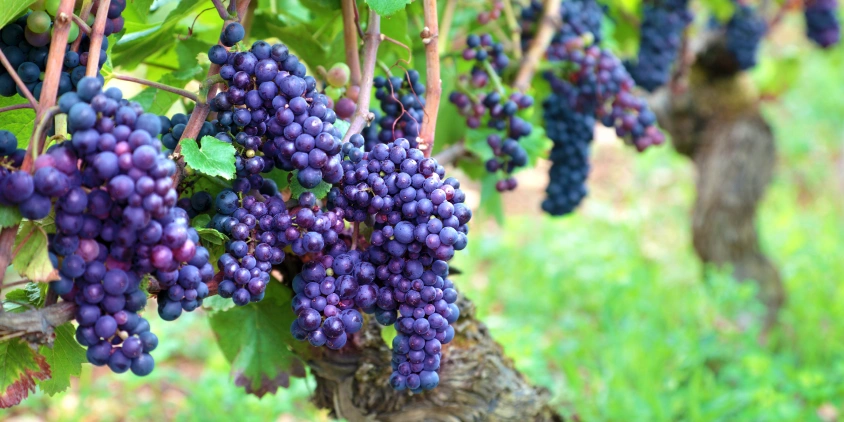
Growing Grapes: How To Plant, Maintain, And Harvest
Commercial grape growing is complex; it takes careful planning and continuous management. The process begins with vineyard establishment: site selection, soil preparation, and planting. Weed, pest, and disease control, water management, and vine nutrition — all these activities create growers’ day-to-day routines. Moreover, climate change is complicating grape cultivation with new variables, demanding new, adaptive strategies. In response to the challenges, old and new, the industry is turning to precision agriculture technologies. Now, winegrowers can keep a closer eye on their vines’ health, use resources more precisely, and make smarter decisions to improve the grape growing process and boost yields.
Selecting Grape Types And Varieties To Grow Commercially
Grapes are broadly categorized as either table or wine. Wine varieties are more intense than table varieties in acidity and sugar content. A more detailed and practical classification recognizes three main groups:
- European varieties dominate the global viticulture and wine industries. These grapes grow well in regions with long, warm summers. However, their sensitivity to colds, pests, and diseases requires particular care throughout the growing season. Despite this, Cabernet Sauvignon, Chardonnay, Malbec, Merlot, Pinot Noir, and Sangiovese are constantly popular among winemakers.
- American varieties boast strong cold tolerance and disease resistance, particularly against Phylloxera. Growing American grape varieties such as Antoinette, Concord, Cayuga, Niagara, and Muscadine is preferable in challenging climates.
- French-American varieties are crossbreeds to combine the wine quality of European varieties with the hardiness of American varieties. Vignerons looking to benefit from this middle ground grow varieties like Baco Noir, Chambourcin, Chardonel, and Vidal Blanc.
Understanding the characteristics of each group can help you make informed decisions based on your growing conditions, intended use, and market demands. This is crucial for winemaking, where deliberate choice of varieties has to suit both your wine style and growing conditions.
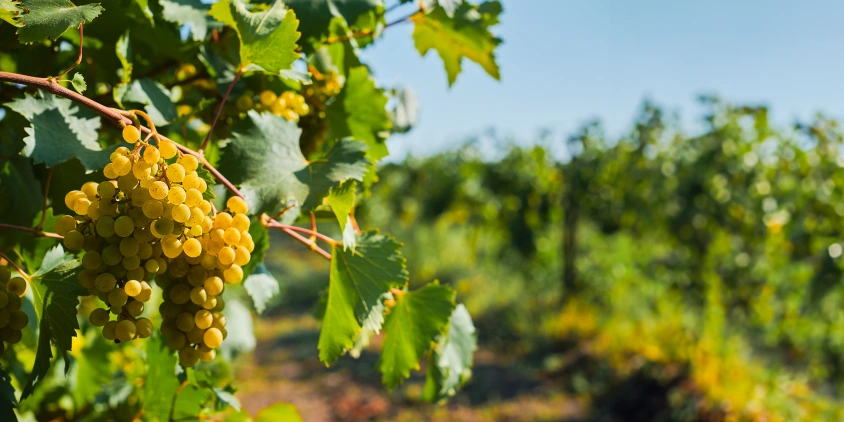
Optimal Growing Conditions For Grapes
Grapes require a unique combination of growing conditions to thrive: abundant sunshine, moderate rainfall, and well-drained soils rich in nutrients. Understanding these optimal growing conditions lays the foundation for productive grape farming.
Rainfall
Grapes are water-wise plants, flourishing in growing regions with less than 750 mm of annual rainfall. While they grow in wetter climates, excess moisture can pose challenges, especially during critical grape vine growth stages like fruit set and harvest. At the same time, plants subjected to drought stress during heat waves experience stunted root development, vine decline, and reduced yield potential.
The bulk of the world’s supply in 2023 was cultivated in China, even though Southern European countries — specifically Italy, France, and Spain — have historically been the leaders in grape growing . Their loss in leadership is largely due to climate-change-related extreme weather events such as dry spells, heavy rains, and storms, impeding the growing process.
Vignerons shouldn’t wait for visible water stress signs to irrigate, and in consistently dry growing regions, permanent irrigation systems may be necessary. For proactive management, access to reliable historical climate data is essential. EOSDA Crop Monitoring offers comprehensive weather insights (precipitation, humidity, temperature, evapotranspiration, and more). By leveraging the platform’s 5-year average daily metrics, winegrowers can make informed decisions about site selection and develop robust, long-term water management strategies.
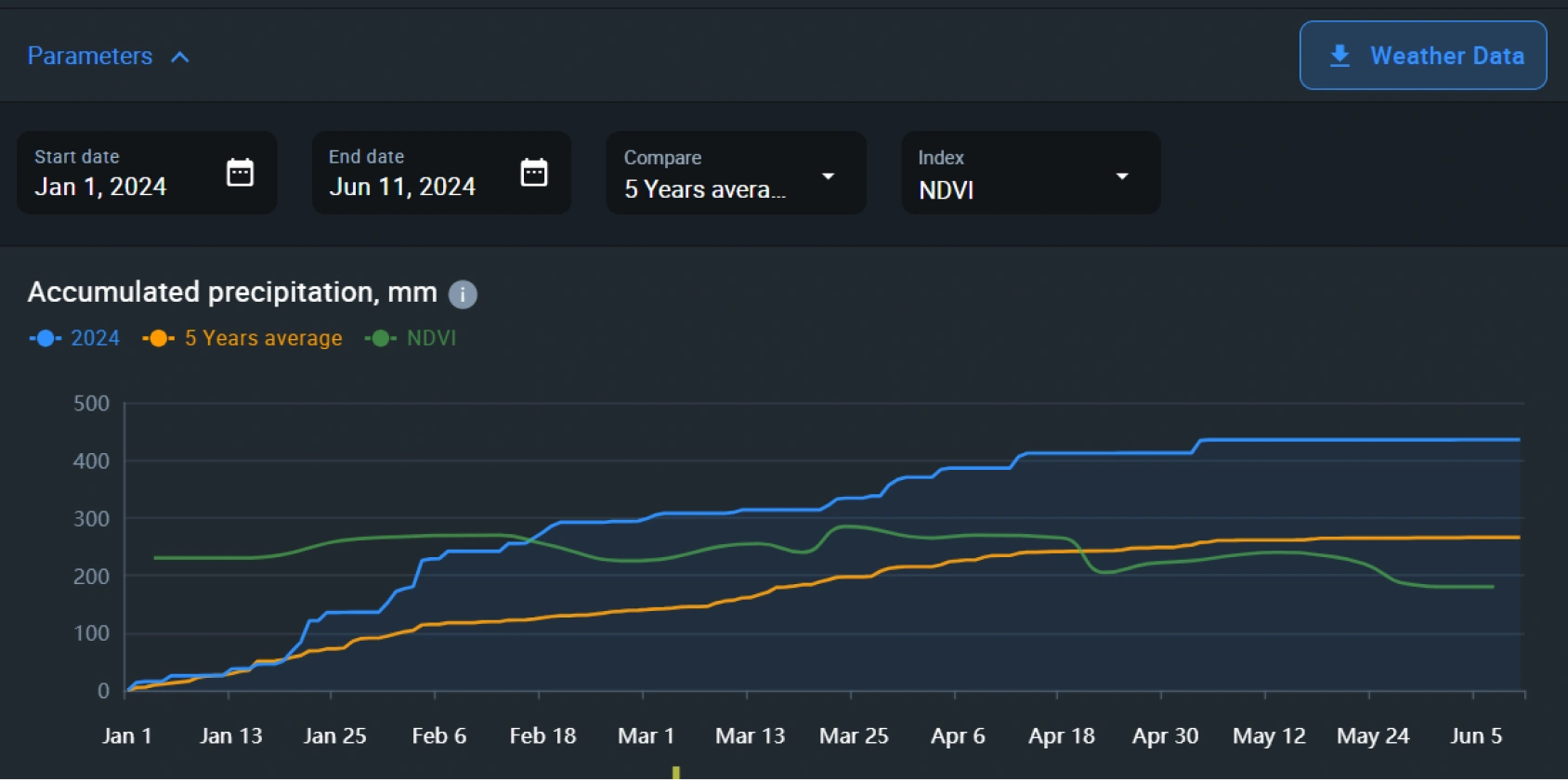
Temperature
The most intense growth occurs between 77 and 90°F (25 and 32°C). Outside this range, vine productivity declines. Cooler temperatures limit vegetative grape growth, while higher temperatures reduce photosynthesis because of increased respiration.
Most varieties robustly grow in regions with mean yearly temperatures of 50–68°F (10–20°C). Below 50°F (10°C), growth is stunted.
A successful vineyard requires cold winters to trigger dormancy and a long growing season to allow for fruit formation and maturation. Frost, however, poses a significant threat to growing grape vines. Temperatures below 25°F (-4°C) can injure leaves, kill immature shoots, and harm flower clusters, potentially halting fruit set.
Sun
Grape vines require a minimum of 7 hours of direct sun daily to yield an abundance of sweet fruit. Although vines can grow in partially shaded areas, this often results in lower yields and inferior fruit quality. Limited sun exposure also makes growing vines more susceptible to diseases like powdery mildew and fruit rot.
Soil
Grape vines are adaptable to various soil types, from sandy to clayey. However, grape growing hinges on soil drainage, depth, and pH balance:
- Well-drained soil is essential for growing healthy vines. Constantly soggy or damp growing conditions can lead to root diseases and poor fruit quality. Well-drained and warm gravelly soils are particularly beneficial for grapes.
- Vines thrive in deep, loose soils, as their root systems typically grow at least 36 inches (91 cm) below the surface. Growing in deep soil enhances the vines’ resilience to drought and other environmental stresses.
- The ideal soil pH for growing grapes ranges from 5.5 to 6.5 . This slightly acidic-to-neutral range promotes optimal nutrient availability. Soils outside this range may require amendments to achieve the best growing conditions for your vineyard.
How To Prepare Soil For Growing Grapes
Proper soil conditions are key to establishing a thriving commercial vineyard. Begin by conducting a soil test several weeks before planting grapes to analyze nutrient content, especially potassium levels, which are vital for growing vines. Use these results to develop a tailored fertilization plan that addresses any deficiencies.
Next, focus on deep soil preparation. Loosen and thoroughly mix soil layers to depths of 36 inches (91 cm) or more, creating an environment that supports root growth, enhances drainage, and promotes vines’ access to nutrients throughout the soil profile.
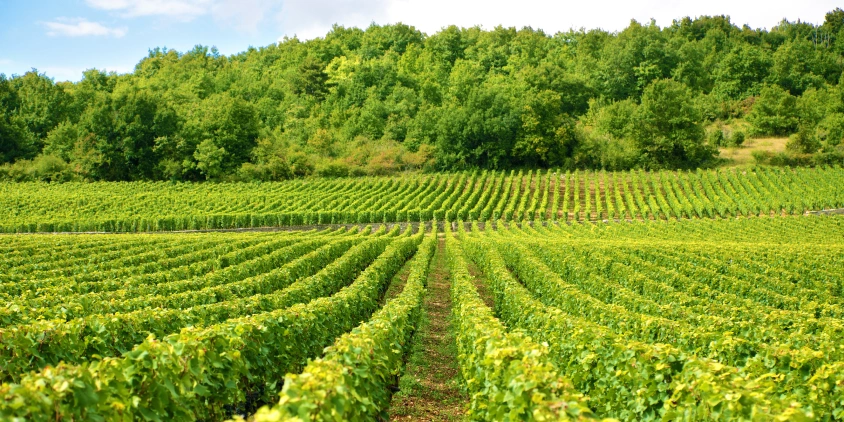
Best Practices For Planting Grapes
Establishing a new vineyard starts with crucial decisions about plant selection. While autogenous grape vines can be planted in phylloxera-free areas, most commercial vignerons prefer growing from grafted vines. For the vineyard’s future prosperity and operational efficacy, it is also necessary to consider site capacity, topography, and equipment requirements.
When To Plant
When it comes to planting grapes, location dictates timing. In cooler, northern growing regions, aim to get your vines in the ground as soon as the soil thaws in spring. Southern growers can take advantage of milder autumns for planting. The key is giving your vines enough time to establish themselves before summer’s heat arrives.
Temperatures consistently climbing above 50°F (10°C) mark the beginning of the vine’s annual growth cycle. In the northern growing regions, this typically happens around March, while in the southern growing regions, it happens around September.
How Densely To Plant
Effective vineyard layout balances space efficiency with operational needs. Headlands should be at least 30 feet (9 m) wide to allow for anchoring systems and machinery maneuvering. Row spacing — generally 8 to 10 feet (2.4 to 3 m), reduced to 7 to 8 feet (2.1 to 2.4 m) for less vigorous varieties — is also influenced by equipment requirements and trellis system, with horizontally divided canopy trellis systems demanding more space.
Grape vine planting density varies regionally:
- European vineyards — 4 to 5 thousand vines/acre (9.9 to 12.3 thousand vines/ha);
- American and Australian vineyards — 1.1 to 1.6 thousand vines/acre (2.7 to 4 thousand vines/ha).
Decisions about grape planting distance and density are critical to further vineyard management and its overall productivity.
How To Care For Grape Vines
Growing grapes isn’t just about planting and harvesting — it’s a year-round labor. We’ll walk you through the key steps of grape vine care during the growing season, covering everything from pruning and trellising to managing soil nutrients and pests.
Pruning And Suckering Grape Vines During Growing Season
Pruning and suckering are vital practices in the commercial cultivation of grapes. Unpruned vines suffer from:
- reduced sugar accumulation;
- low pigmentation;
- poorer flavor and aroma;
- less vigor and smaller vines.
Prune grape vines during the growing season to control vine growth and prevent excessive clusters (bunches) that compromise fruit quality. In most climates, the procedure is most effective during the dormant season. Suckering removes unwanted shoots from growing in the trunk and underground, redirecting energy to productive areas. It’s critical in spring and early summer. By managing the canopy, vineyard operators ensure balanced energy distribution for growing high-quality grapes.
Well-Designed Trellising
Growing grape vines rely on trellising for structural integrity, as their trunks lack natural rigidity. Trellis designs range from basic high cordon single-wire arrangements to sophisticated multi-tiered systems like the Lyre trellis. A thoughtfully implemented trellis system serves multiple purposes:
- supporting growing fruit load;
- ensuring even sunlight distribution;
- facilitating air movement through the canopy;
- reducing disease pressure .
Sufficient Irrigation
Mastering grape irrigation necessitates a thorough understanding of various factors, from vine characteristics to local climate patterns. The vine’s annual growth cycle serves as a roadmap for water management, with each stage presenting unique hydration needs. Vines between flowering and fruit set are particularly vulnerable to water stress, which could negatively impact flower cluster development and berry set.
For commercial grape growing, where time is key, EOSDA Crop Monitoring helps stay ahead of water stress. The platform’s heat stress detection provides an up-to-14-day warning system, which allows you to set variety-specific thresholds and receive timely alerts. Additionally, a comprehensive weather forecast on our platform includes a range of meteorological parameters, far beyond temperature and precipitation, essential for the timely and precise watering of grape vines.
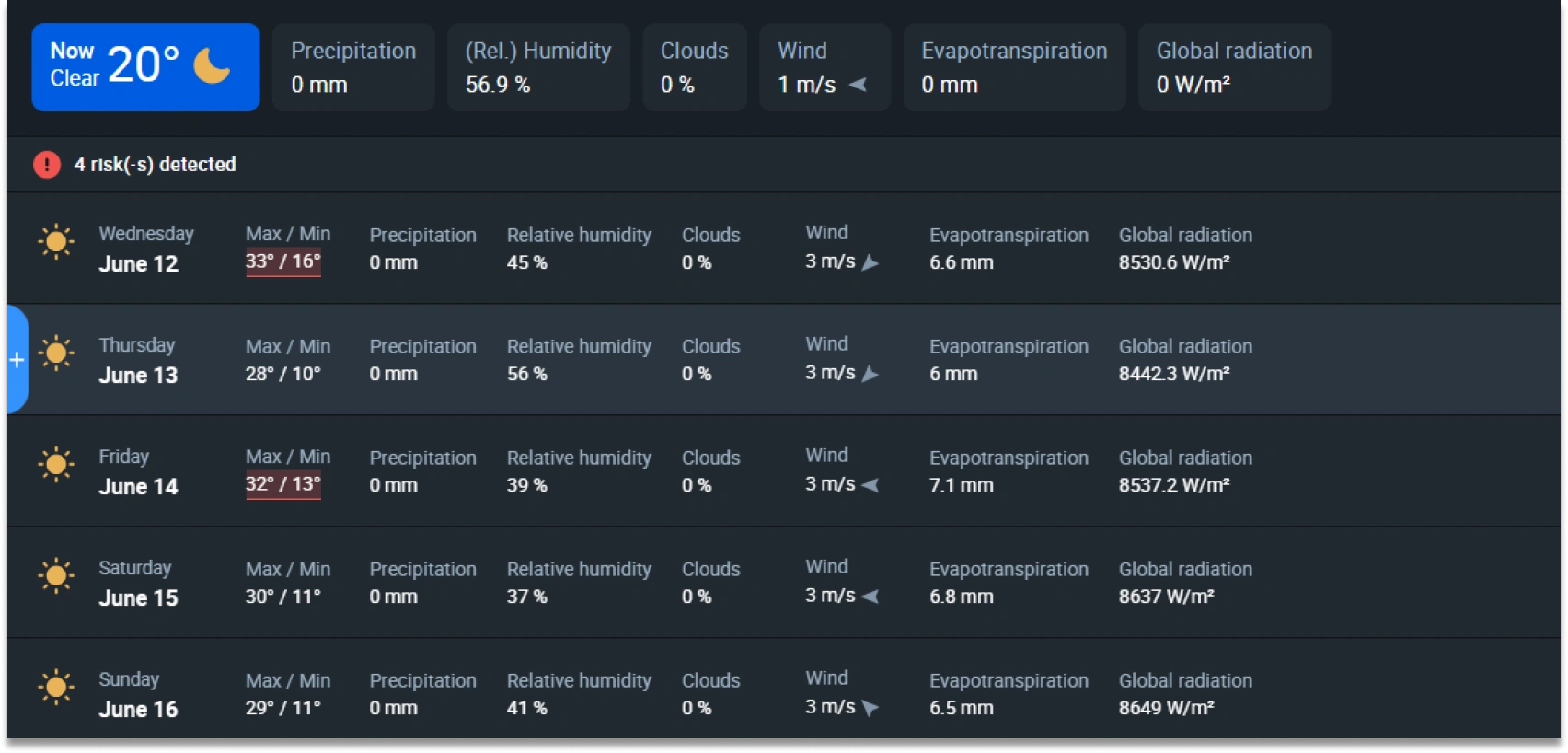
Timely And Precise Fertilizing
Fertilizing grapes is a critical vineyard maintenance process, with three main application periods:
- at bud break in spring, to support fast tissue expansion;
- within 3 weeks after fruit set, to promote berry development;
- post-harvest, to help vines accumulate carbohydrates for winter and early spring growth.
Nitrogen fertilizer application spans from bud break to fruit set or after harvest, phosphorus should be banded/broadcasted in fall or spring, and potassium should be banded/broadcasted in late fall or early winter for optimal root uptake throughout the grape growing season.
While the timing of fertilization is crucial, modern large-scale grape growing also demands precision. To meet this need, growers are turning to advanced crop monitoring technologies like EOSDA Crop Monitoring, which offer high productivity for extensive vineyards. Our sophisticated Map builder integrates crucial data on moisture, elevation, and vegetation — a comprehensive view of your vineyard conditions. Users can customize the opacity of each data layer, and by specifying the number of zones and levels of detail, they can obtain an accurate analysis of specific zones within their vineyards to tailor applications.
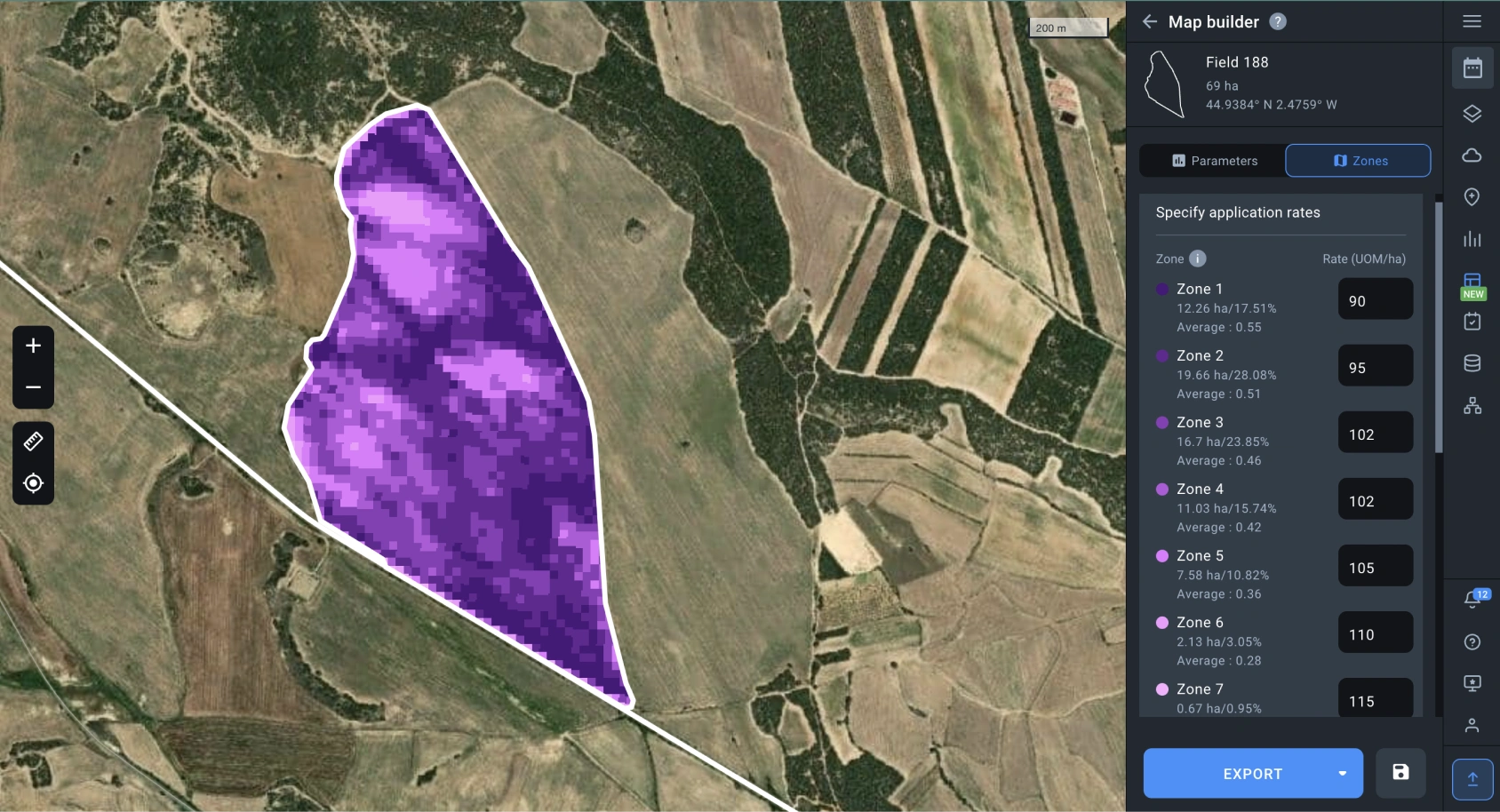
Weed Management In Young Vineyards
Weed management is particularly important during the first three years after planting and from bloom to veraison (onset of ripening) in established vines. During these periods, weeds compete with growing grapes for resources, potentially decreasing survival, retarding growth, and delaying production. They may also interfere with vineyard operations.
Surprisingly, winter weed growth is often beneficial, aiding soil conservation and improving vineyard accessibility outside the growing season. Effective control strategies should focus on critical growth stages while leveraging the potential benefits of controlled weed presence during dormant periods.
Proactive Pest And Disease Management
Pests and diseases are ever-present threats to grape cultivation, requiring constant monitoring and management. The table below serves as a quick reference guide for identifying and addressing common ailments.
| Pest/Disease | Symptoms | Control |
|---|---|---|
| Black rot |
|
|
| Gray mold (Botrytis bunch rot) |
|
|
| Downy mildew |
|
|
| Anthracnose |
|
|
| Phomopsis cane and leaf spot |
|
|
| Powdery mildew |
|
|
| Grape phylloxera |
|
|
| Mealybugs |
|
|
Winegrowers recognize that early detection is everything when combating pests and diseases. While regular on-site inspections by agronomists can help detect early signs, without knowing the hotspots, they’re not always practical for large vineyards.
That’s where satellite monitoring shines. By leveraging vegetation indices such as NDVI in EOSDA Crop Monitoring, you can identify potential trouble spots across your entire vineyard from above. Abnormal NDVI readings frequently indicate leaf discoloration in growing grape vines, an early warning sign of pest or disease activity that requires further on-site investigation.
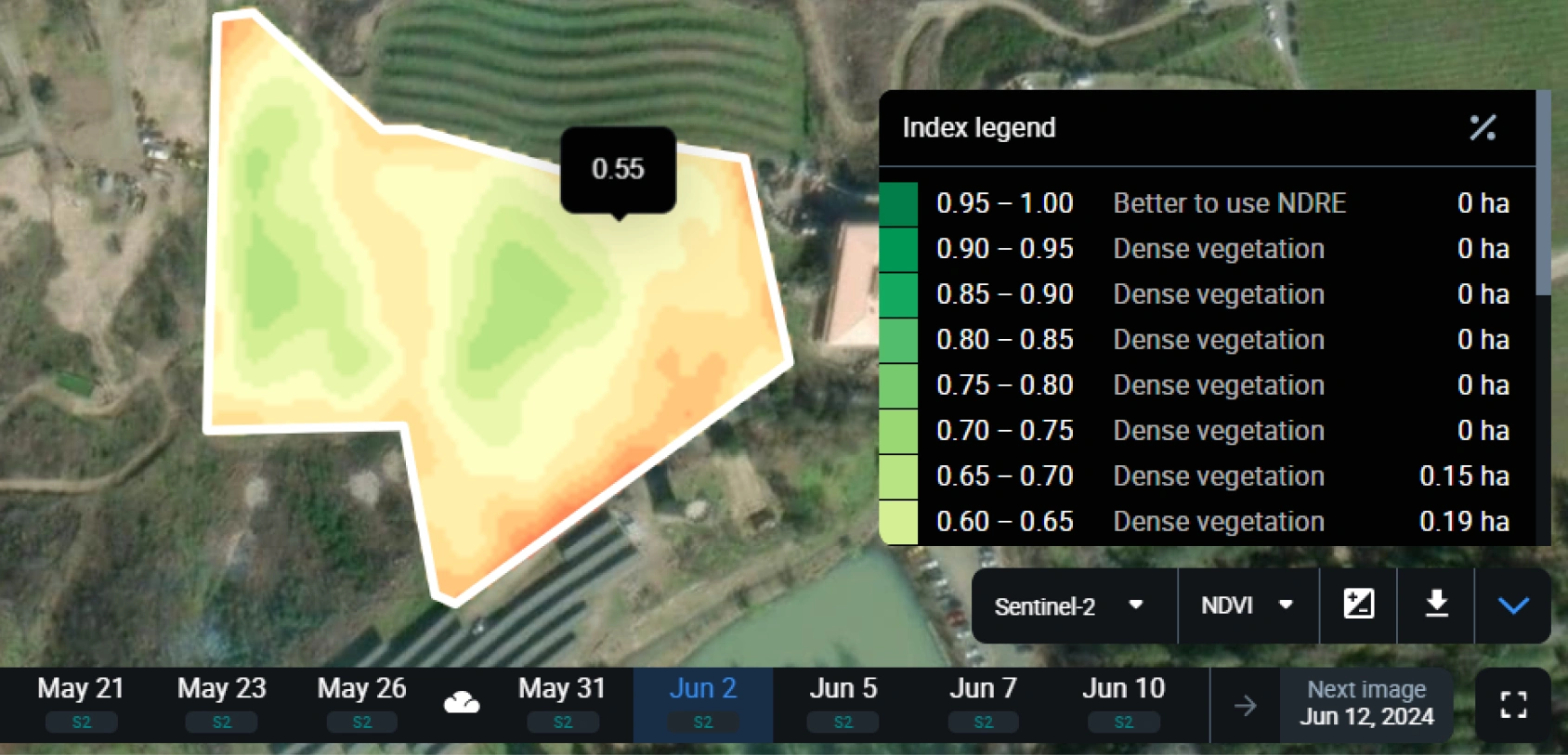
On top of that, our crop monitoring platform informs agricultural consultants and large-scale winegrowers to take vineyard protection a step further. Our Disease risk feature combines local weather forecasts with grape vine growth stages to predict potential outbreaks. This empowers you to take preemptive action, safeguarding your growing crop and optimizing resources.
How Long Do Grapes Take To Grow?
For the first three years after planting, grape vines channel their energy into growing robust root systems rather than fruit production. This sets the stage for decades of harvests once the vines grow mature in their third year. From this point on, each growing season brings a new fruiting cycle, typically spanning 12–16 weeks from bloom to harvest.
The full vegetation period varies widely among varieties: early-ripening varieties complete their annual cycle in as little as 95 to 120 days, while late-ripening types may require up to 170 days to grow fruits, with exact timelines influenced by vineyard location and the year’s unique weather patterns.
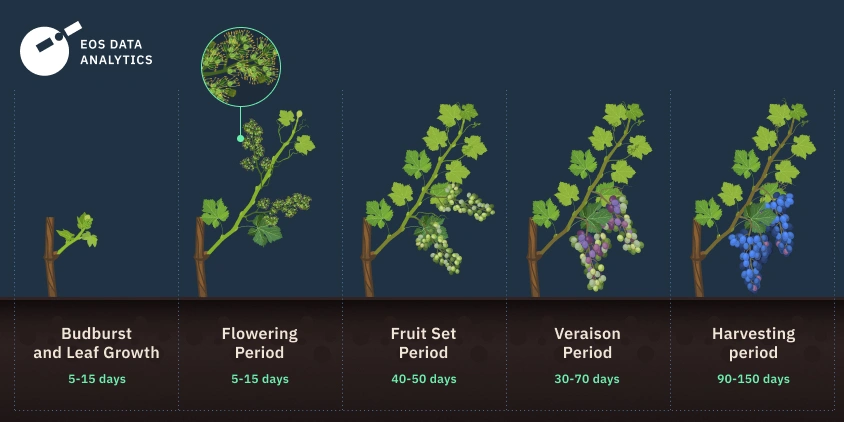
Grape Harvest Timing And Process
The grape harvest season is the culmination of a vineyard’s annual cycle, where the decisions made in these critical weeks can make or break a vintage. For large-scale producers, this period requires finding a balance between maximizing yield and ensuring optimal fruit quality.
When To Harvest
Determining the optimal harvest time is crucial for grape quality and wine production. At the end of the growing season, farmers monitor three key parameters.
| Parameter | Change during ripening | Optimal level |
|---|---|---|
| Sugar content | Increase | 150–250 g/l |
| Titratable acidity (TA) | Decrease | 5.0–16.0 g/l |
| pH | Increase | 3.4 for most varieties |
The process of veraison (July–August in most climates), when berries change color and soften, signals the beginning of ripening. While historical grape harvest dates can serve as a reference point, growing conditions and management practices all play important roles in determining the ideal harvest time. To pick grapes at their best, growers begin sampling berries several weeks before the expected harvest, increasing frequency as time approaches.
EOSDA Crop Monitoring provides a virtual command center for vineyard operation, allowing you to streamline the pre-harvest decision-making process. Our Scouting feature lets you manage multiple fields effortlessly, with just a few clicks dispatching scouts to assess grape maturity. Comprehensive reports, complete with photos, give you a clear picture of your crop’s status. And when it’s time to act, our Field activity log helps you coordinate harvest activities across all your fields.
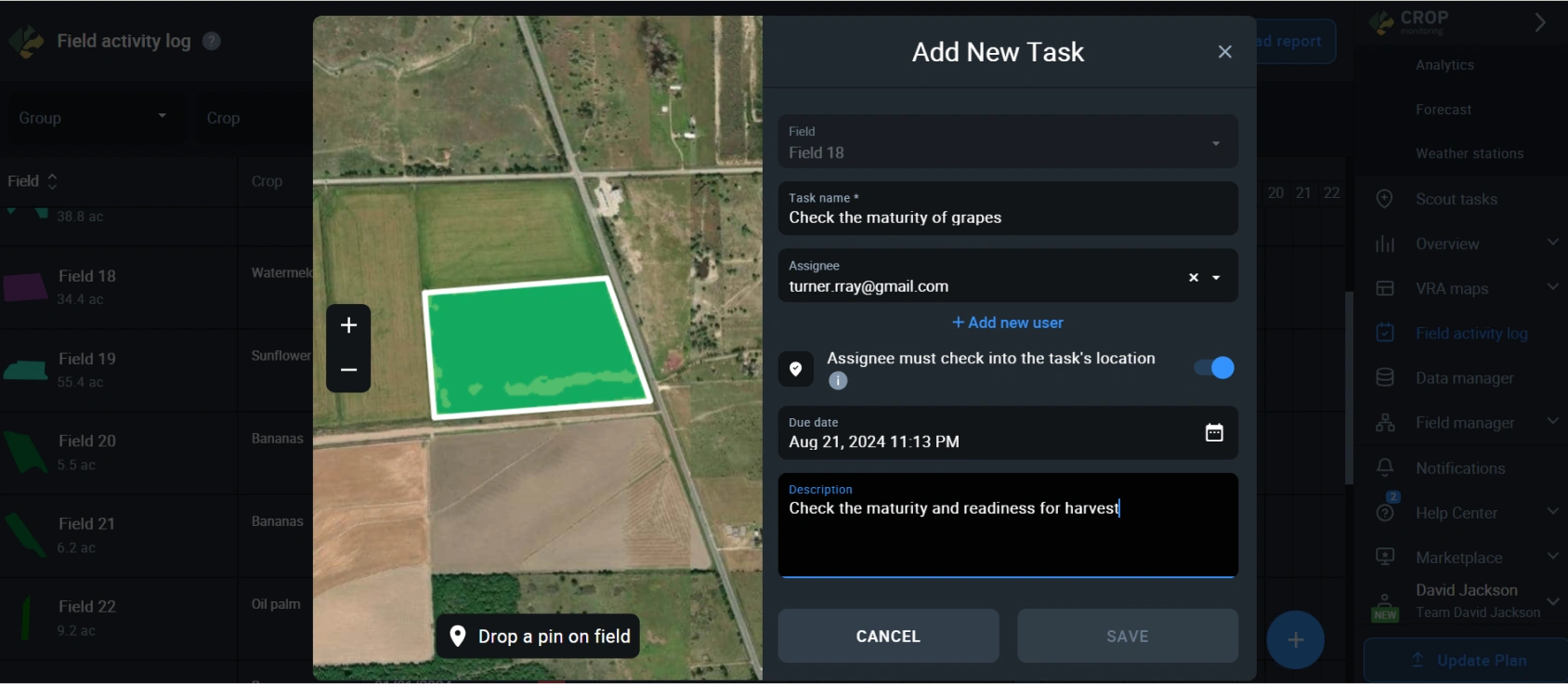
How To Harvest
Grape harvesting can be done manually or mechanically, each with its nuances. Manual harvesting, preferred for delicate varieties and premium wines, allows for selective picking of ripe clusters. It is labor-intensive but gentle on the berries and vines. Mechanical harvesting, efficient for large vineyards, can operate at night, preserving grape freshness, but may cause some damage to berries and vines.
As the wine industry continues to evolve, so do the methods for growing exceptional grapes. By embracing innovative technologies and sustainable practices, growers can optimize their yields while preserving the unique flavor profile that defines their berries. Whether you’re managing a small vineyard or overseeing vast hectares of vines, the key to success lies in staying informed and adapting to changing growing conditions. Contact our sales team at sales@eosda.com to learn more about how EOSDA Crop Monitoring and our custom solutions can inform vineyard owners’ decision-making.
About the author:
Vasyl Cherlinka is a Doctor of Biosciences specializing in pedology (soil science), with 30 years of experience in the field. He attended the engineering college in Ukraine and received his degree in agrochemistry, agronomy and soil science in the Chernivtsi National University. Since 2018, Dr. Cherlinka has been advising EOSDA on problems in soil science, agronomy, and agrochemistry.
Recent articles

Analyze 2025 & Plan Your Best Year Yet: LandViewer Christmas Offer
It’s the most wonderful time of the year! The Christmas holidays are here, and so is your chance to analyze 2025 and plan a prosperous 2026 with more affordable Pro plans in LandViewer.

EOSDA Models Climate Change Impact On Sugarcane Yields
EOSDA modeled future temperature, rainfall, and other climate impacts on Veracruz sugarcane. The results help growers plan long-term adaptation strategies, including timing, varieties, and irrigation.

EOSDA LandViewer Black Friday Sale: Exclusive Offers & Giveaway
This Black Friday, LandViewer offers new users the chance to save on monthly plans, get extra months with yearly subscriptions, and participate in a free annual plan giveaway.